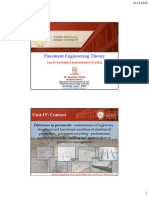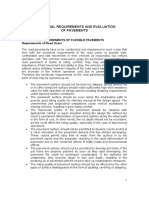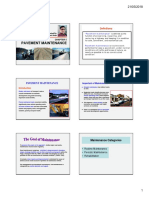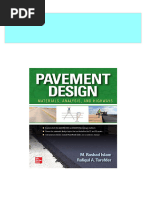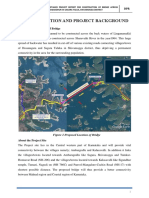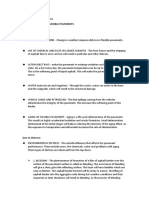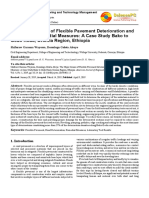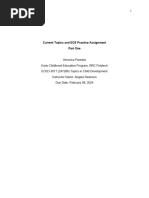Pavement Management System Text Book
Uploaded by
Goutham AthemPavement Management System Text Book
Uploaded by
Goutham Athem1 Introduction
1.1 Background In the past, pavements were maintained, but not managed. The pavement engineer's experience tended to dictate the selection of Maintenance and Repair (M&R) techniques with little regard given to life cycle costing nor to priority as compared to other pavement requirements in the network. In today's economic environment, as the pavement infrastructure has aged, a more systematic approach to determining M&R needs and priorities is necessary. Pavement networks must now be managed, not simply maintained. Recent developments in microcomputers and pavement management technology have provided the tools needed to manage pavements economically. A Pavement Management System (PMS) provides a systematic, consistent method for selecting M&R needs and determining priorities and the optimal time of repair by predicting future pavement condition. The consequences of poor maintenance timing are illustrated in Figure 1-1. If M&R is performed during the early stages of deterioration, before the sharp decline in pavement condition, over 50% of repair costs can be avoided. In addition to cost avoidance, long periods of closure to traffic and detours can also be avoided. A PMS is a valuable tool that alerts the pavement manager to the critical point in a pavement's life cycle. 1.2 Project vs. Network Level Management "Project-level" management often includes performing in-depth pavement evaluation and design for the pavement sections in the project. The end product is to select the specific M&R type(s) to be performed as well as the layer thicknesses when applicable. Project management can be performed with little or no consideration given to the resource requirements of other pavement sections in the network. This is acceptable as long as money is abundant, but this is seldom the case. In the past, most pavement
2 / Pavement Managementfor Airports, Roads, and Parking Lots
GOOD SATISFACTORY H FAIR POOR VERY POOR-]
WILL COST $4.00 TO $5.00 HERE $1.00 FOR REHABILITATION HERE
SERIOUS -I
FAILED TIME Figure 1-1. Conceptual illustration of a pavement condition life cycle.
engineers have been trained to work at the project level. Top management is now demanding budget projection that considers the agency's entire network before projects are prioritized and executed. 1.3 The Pavement Management Process The ad hoc approach to pavement management normally leads to gradual deterioration in the overall condition of the pavement network and thus increased backlog of unfunded major M&R requirements. This approach consists of the habitual application of selected few M&R alternatives (such as 1.5 inch overlay) to pavement that are either in very poor condition or politically important. This is normally done regardless of the needs of the other pavements in the network. A systematic approach to pavement management is needed to insure optimum return on investment. The following approach has evolved over the past thirty years as part of the development of the PAVER pavement management system (Micro PAVER 2004). The approach is a process that consists of the following steps: 1.3.1 Inventory definition (Chapter 2) The pavement network is broken into branches and sections. A branch is an easily identifiable entity with one use, i.e. a runway, taxiway, roadway, etc.. Each branch is divided into uniform sections based on construction, condition, and traffic. A section can only be of the same pavement type, i.e. asphalt or concrete. A section can also be viewed as the smallest pavement area where major M&R, such as overlay or reconstruction, will be scheduled. Section identification is normally performed using AutoCAD or Geographical Information systems (GIS). This allows the creation of GIS shape files which are useful to display pavement data.
Introduction/3
1.3.2 Pavement Inspection (Chapters 3, 4, 5, and 6) 1.3.2.1 A irfield Pavements At a minimum, pavement inspection consists of a distress survey every 1 to 5 years. Skid resistance measurement and Nondestructive Deflection Testing (NDT) are normally performed every 5 to 10 years. Runway longitudinal profile measurement is usually not performed unless there is a pilot complaint about pavement roughness. 1.3.2.2 Roadways and Parking Lots It is recommended that distress surveys be performed every three years in order to meet the GASB 34 requirements. If automated data collection is used for the roadway survey, then both longitudinal and transverse profiles are measured. The longitudinal profile is usually measured for the right and left wheel path. NDT is usually not performed except for project level management. 1.3.3 Condition Assessment (Chapters 3, 4, 5, and 6) 1.3.3.1 Airfield Pavements The inspection results are reduced to condition indicators that can be used for pavement management. A widely used distress index is the Pavement Condition Index (PCI). The PCI for airfields (Shahin et al. 1977), ASTM D5340, is a score from 0 to 100 that measures the pavement structural integrity (not capacity) and surface operational condition. It correlates with the needed level of M&R and agrees closely with the collective judgment of experienced pavement engineers. The skid resistance data is reduced to africtionindex for the runway. The NDT data is reduced to a structural index such as the Aircraft Classification Number/ Pavement classification Number (ACN/PCN). 1.3.3.2 Roadways and Parking Lots Similar to airfield pavements, a PCI for roads and parking lots is calculatedfromthe gathered distress data (Shahin etal. 1981), ASTM 6433. The longitudinal profile is used to calculate the International Roughness Index (IRI), ASTM El926. The pavement section IRI is the average IRI of the right and left wheel path. The transverse profile is used to calculate the pavement rutting depth or rutting index. 1.3.4 Condition Prediction (Chapter 7) There is no such thing as one prediction model that will work for all locations and conditions. Therefore, it is important that the management system includes a prediction modeling engine that can be used to formulate different models for different locations and conditions. The models are used to predict the future condition of the pavement sections assuming that the traffic will continue to be the same as in the past. An accurate condition prediction is also important for the analysis of different budget consequences.
4 / Pavement Managementfor Airports, Roads, and Parking Lots
1.3.5 Condition Analysis (Chapter 9) Condition analysis allows managers to compare past, current, and future conditions, assuming no major M&R is performed. This provides managers with the ability to assess the consequence of past budget decisions and the value of having a management system, especially if the system has been in place for several years. 1.3.6 Work Planning (Chapters 8, 10, and 11) Work planning provides the ability to determine budget consequence for a specified budget or, alternately, budget requirements to meet specified management objectives. Typical management objectives include maintaining current network condition, reaching a certain condition in x years, or eliminating all backlog of major M&R in x years. Regardless of the analysis scenario, the output should include the recommended M&R category for each pavement section for each year of the analysis. Projects are formulated by grouping sections to minimize cost and traffic delays. 1.4 Book Organization The book is organized in the same logical sequence of the pavement management process. Pavement network definition is presented in Chapter 2. Pavement condition measurement is presented in Chapters 3 through 6. The chapters cover distress, deflection, roughness, and skid, respectively. Pavement condition prediction is presented in Chapter 7. It is important to realize that pavement condition prediction is an important part of the pavement management process. The accuracy of the prediction will influence the accuracy of both the network and project level analysis. Chapter 8 presents an introduction to M&R techniques as a background for work planning. The network level pavement management analysis is presented in Chapters 9 and 10. Chapter 9 presents the inventory and condition reporting while Chapter 10 presents the M&R work planning. The project level analysis is presented in Chapter 11. Chapters 12 through 14 present special applications where pavement management technology is used to address specific questions. Chapters 12 and 13 address the impact of buses and utility cut patching on pavement life and rehabilitation cost. Chapter 14 addresses M&R budget allocation among city council districts. Chapter 15 provides a summary of pavement management implementation steps and benefits. Figure 1-2 is aflowchart of the book organization.
Introduction / 5
CHAPTER 1
Introduction to Pavement Management
CHAPTER 2
Pavement Network Definition
1 CHAPTERS Survey and Rating
PAVEMENT CONDITION MEASUREMENT
CHAPTER 4
1
CHAPTERS
Non-Destructive Deflection Testing (NDT)
CHAPTERS
Roughness Measurement
Skid Resistance Measurement
CHAPTER 7
Pavement Condition Prediction
CHAPTERS
Overview of Maintenance and Rehabilitation Techniques
NETWORK LEVEL PAVEMENT MANAGEMENT
CHAPTER* CHAPTER 10
Inventory and Condition Reporting
M&R Work Planning
CHAPTER 11
Project Level Management
PAVEMENT MANAGEMENT SPECIAL APPLICATIONS
CHAPTER 12 CHAPTER 13
Impact of Bus Traffic on Pavement Rehabilitation Cost
Impact of Utility Cut Patching on Pavement Life and Rehabilitation Cost
CHAPTER 14 1 Development of Council District Budget Allocation Methodology for Pavement Rehabilitation |
CHAPTER 15
Pavement Management Implementation Steps and Benefits
Figure 1-2. Book Organization.
6 / Pavement Management for Airports, Roads, and Parking Lots
References
American Public Works Association (APWA), 2004. e-mail: paver@apwa.net web: www.apwa.net/about/SIG/MicroPAVER ASTM D5340, Standard Test Method for Airport Pavement Condition Index Surveys. ASTM D6433, Standard Practice for Roads and Parking Lots Pavement Condition Index Surveys. ASTM E 1926, Standard Practice for Computing International Roughness Index of Roads from Longitudinal Profile Measurements. Shahin, M. Y, Darter, M. I., and Kohn, S. D. (1976-1977). Development of a Pavement Maintenance Management System, Vol. I-V. U.S. Air Force Engineering Services Center (AFESC), Tyndall AFB. Shahin, M. Y. and Kohn, S. D. (1981). Pavement Maintenance Management For Roads and Parking Lots. Technical Report M-294. U.S. Army Construction Engineering Laboratory. University of Illinois at Urbana-Champaign (UIUC) Technical Assistance Center (TAC), 2004. e-mail: techctr@uiuc.edu web: www.tac.uiuc.edu U.S. Army Engineering Research and Development Center-Construction Engineering Research Laboratory (ERDC-CERL), 2004. Micro PAVER Pavement Management System, 2004. e-mail: paver@cecer.army.mil web: www.cecr.army.mil/paver
You might also like
- Road Inventory and Pavement Condition Survey - 28.05.202075% (4)Road Inventory and Pavement Condition Survey - 28.05.202059 pages
- Shahin 1994, Pavement For Airports, Roads, Parking LotsNo ratings yetShahin 1994, Pavement For Airports, Roads, Parking Lots30 pages
- Unit-IV Pavement Management System 2023No ratings yetUnit-IV Pavement Management System 202368 pages
- Slides Pavement Condition Index (Pci) - Group 4100% (1)Slides Pavement Condition Index (Pci) - Group 439 pages
- A Project Report On: Design of A Rigid PavementNo ratings yetA Project Report On: Design of A Rigid Pavement77 pages
- PowerPoint Presentation ROAD PAVEMENT FAILURE (COREN ASSEMBLY) REVISED FINAL100% (5)PowerPoint Presentation ROAD PAVEMENT FAILURE (COREN ASSEMBLY) REVISED FINAL110 pages
- Comparison of Inverted Pavement With Different Types of Crack Relief Layers - ASCENo ratings yetComparison of Inverted Pavement With Different Types of Crack Relief Layers - ASCE11 pages
- Functional Condition Evaluation of Pavements100% (2)Functional Condition Evaluation of Pavements17 pages
- (26-33) Pavement Maintenance Management System - Revised-FormatNo ratings yet(26-33) Pavement Maintenance Management System - Revised-Format8 pages
- What Is The Difference Between Codes IRC 37-2001 & 2012100% (1)What Is The Difference Between Codes IRC 37-2001 & 20125 pages
- Pavement Design, Construction and Maintenance For Bituminous RoadsNo ratings yetPavement Design, Construction and Maintenance For Bituminous Roads47 pages
- Types of Failures in Rigid Pavements: Presented By, Aglaia100% (2)Types of Failures in Rigid Pavements: Presented By, Aglaia40 pages
- Powerpoint Presentation Road Pavement Failure (Coren Assembly) Revised FinalNo ratings yetPowerpoint Presentation Road Pavement Failure (Coren Assembly) Revised Final110 pages
- Evaluation of Asphalt Pavement Analyzer As A Tool To Predict RuttingNo ratings yetEvaluation of Asphalt Pavement Analyzer As A Tool To Predict Rutting1 page
- AASHTO Design Example: (Rigid Pavements)No ratings yetAASHTO Design Example: (Rigid Pavements)30 pages
- Highway Maintence, Repair and RehabilitationNo ratings yetHighway Maintence, Repair and Rehabilitation32 pages
- Transportation Engineering II: The PavementNo ratings yetTransportation Engineering II: The Pavement76 pages
- Flexible Pavement Distress Identification Manual (2011)No ratings yetFlexible Pavement Distress Identification Manual (2011)78 pages
- A Study Report On Flexible Pavement Construction in VidishaNo ratings yetA Study Report On Flexible Pavement Construction in Vidisha4 pages
- Immediate Download Pavement Design: Materials, Analysis, and Highways 1st Edition M. Rashad Islam Ebooks 2024100% (6)Immediate Download Pavement Design: Materials, Analysis, and Highways 1st Edition M. Rashad Islam Ebooks 202434 pages
- Analysis of Flexible Pavements Using IIT Pave: Harish G RNo ratings yetAnalysis of Flexible Pavements Using IIT Pave: Harish G R4 pages
- Manual Pavement Condition Survey Methodology100% (1)Manual Pavement Condition Survey Methodology3 pages
- Types of Failures in Flexible and Rigid PavementsNo ratings yetTypes of Failures in Flexible and Rigid Pavements6 pages
- 7the Major Causes of Flexible Pavement Deterioration and100% (1)7the Major Causes of Flexible Pavement Deterioration and15 pages
- Use of Rejuvenators in Reclaimed Asphalt Pavement and Aged BitumenNo ratings yetUse of Rejuvenators in Reclaimed Asphalt Pavement and Aged Bitumen28 pages
- 1 Analysis of Loss Cost of Road Pavement DistressNo ratings yet1 Analysis of Loss Cost of Road Pavement Distress20 pages
- Serious - I: Good Satisfactory H Fair PoorNo ratings yetSerious - I: Good Satisfactory H Fair Poor3 pages
- Pavement Management For Airports, Roads and Parking Lots PDF92% (13)Pavement Management For Airports, Roads and Parking Lots PDF573 pages
- Personal Information Mosbahullah Merza Oghli: Professional ExperienceNo ratings yetPersonal Information Mosbahullah Merza Oghli: Professional Experience3 pages
- A Systematic Review of Factors Influencing Knowledge Management and The Nurse Leaders' RoleNo ratings yetA Systematic Review of Factors Influencing Knowledge Management and The Nurse Leaders' Role14 pages
- Nathan Bowman - Environmental Analyst - ResumeNo ratings yetNathan Bowman - Environmental Analyst - Resume3 pages
- DURASHINE® From Tata BlueScope Steel Is India's Most Trusted Brand 2019No ratings yetDURASHINE® From Tata BlueScope Steel Is India's Most Trusted Brand 20192 pages
- Immediate Download Small Format Aerial Photography James S. Aber Ebooks 2024100% (11)Immediate Download Small Format Aerial Photography James S. Aber Ebooks 202460 pages
- Mason Et Al 2011 Learning To (Dis) Engage The Socialising Experiences of Young People Living in Areas of Socio-Economic DisadvantageNo ratings yetMason Et Al 2011 Learning To (Dis) Engage The Socialising Experiences of Young People Living in Areas of Socio-Economic Disadvantage19 pages
- Title: Emergence of Telemedicine in Greater Accra Region - Challenges and Opportunities Chapter 1: Introduction 1.1 Background To The StudyNo ratings yetTitle: Emergence of Telemedicine in Greater Accra Region - Challenges and Opportunities Chapter 1: Introduction 1.1 Background To The Study8 pages
- Describe The Purpose of Teaching Practice. Do You Want Any Change in The Mode of Teaching Practice in Bangladesh? ExplainNo ratings yetDescribe The Purpose of Teaching Practice. Do You Want Any Change in The Mode of Teaching Practice in Bangladesh? Explain14 pages
- Specialised English New Directions in ESP EAP Research Practice 1st edition by Hyland Ken, Lillian Wong 9780429959837 0429959834instant download100% (2)Specialised English New Directions in ESP EAP Research Practice 1st edition by Hyland Ken, Lillian Wong 9780429959837 0429959834instant download80 pages
- Road Inventory and Pavement Condition Survey - 28.05.2020Road Inventory and Pavement Condition Survey - 28.05.2020
- Shahin 1994, Pavement For Airports, Roads, Parking LotsShahin 1994, Pavement For Airports, Roads, Parking Lots
- PowerPoint Presentation ROAD PAVEMENT FAILURE (COREN ASSEMBLY) REVISED FINALPowerPoint Presentation ROAD PAVEMENT FAILURE (COREN ASSEMBLY) REVISED FINAL
- Comparison of Inverted Pavement With Different Types of Crack Relief Layers - ASCEComparison of Inverted Pavement With Different Types of Crack Relief Layers - ASCE
- (26-33) Pavement Maintenance Management System - Revised-Format(26-33) Pavement Maintenance Management System - Revised-Format
- What Is The Difference Between Codes IRC 37-2001 & 2012What Is The Difference Between Codes IRC 37-2001 & 2012
- Pavement Design, Construction and Maintenance For Bituminous RoadsPavement Design, Construction and Maintenance For Bituminous Roads
- Types of Failures in Rigid Pavements: Presented By, AglaiaTypes of Failures in Rigid Pavements: Presented By, Aglaia
- Powerpoint Presentation Road Pavement Failure (Coren Assembly) Revised FinalPowerpoint Presentation Road Pavement Failure (Coren Assembly) Revised Final
- Evaluation of Asphalt Pavement Analyzer As A Tool To Predict RuttingEvaluation of Asphalt Pavement Analyzer As A Tool To Predict Rutting
- Flexible Pavement Distress Identification Manual (2011)Flexible Pavement Distress Identification Manual (2011)
- A Study Report On Flexible Pavement Construction in VidishaA Study Report On Flexible Pavement Construction in Vidisha
- Immediate Download Pavement Design: Materials, Analysis, and Highways 1st Edition M. Rashad Islam Ebooks 2024Immediate Download Pavement Design: Materials, Analysis, and Highways 1st Edition M. Rashad Islam Ebooks 2024
- Analysis of Flexible Pavements Using IIT Pave: Harish G RAnalysis of Flexible Pavements Using IIT Pave: Harish G R
- 7the Major Causes of Flexible Pavement Deterioration and7the Major Causes of Flexible Pavement Deterioration and
- Use of Rejuvenators in Reclaimed Asphalt Pavement and Aged BitumenUse of Rejuvenators in Reclaimed Asphalt Pavement and Aged Bitumen
- Pavement Management For Airports, Roads and Parking Lots PDFPavement Management For Airports, Roads and Parking Lots PDF
- Personal Information Mosbahullah Merza Oghli: Professional ExperiencePersonal Information Mosbahullah Merza Oghli: Professional Experience
- A Systematic Review of Factors Influencing Knowledge Management and The Nurse Leaders' RoleA Systematic Review of Factors Influencing Knowledge Management and The Nurse Leaders' Role
- DURASHINE® From Tata BlueScope Steel Is India's Most Trusted Brand 2019DURASHINE® From Tata BlueScope Steel Is India's Most Trusted Brand 2019
- Immediate Download Small Format Aerial Photography James S. Aber Ebooks 2024Immediate Download Small Format Aerial Photography James S. Aber Ebooks 2024
- Mason Et Al 2011 Learning To (Dis) Engage The Socialising Experiences of Young People Living in Areas of Socio-Economic DisadvantageMason Et Al 2011 Learning To (Dis) Engage The Socialising Experiences of Young People Living in Areas of Socio-Economic Disadvantage
- Title: Emergence of Telemedicine in Greater Accra Region - Challenges and Opportunities Chapter 1: Introduction 1.1 Background To The StudyTitle: Emergence of Telemedicine in Greater Accra Region - Challenges and Opportunities Chapter 1: Introduction 1.1 Background To The Study
- Describe The Purpose of Teaching Practice. Do You Want Any Change in The Mode of Teaching Practice in Bangladesh? ExplainDescribe The Purpose of Teaching Practice. Do You Want Any Change in The Mode of Teaching Practice in Bangladesh? Explain
- Specialised English New Directions in ESP EAP Research Practice 1st edition by Hyland Ken, Lillian Wong 9780429959837 0429959834instant downloadSpecialised English New Directions in ESP EAP Research Practice 1st edition by Hyland Ken, Lillian Wong 9780429959837 0429959834instant download













